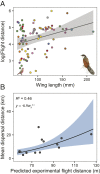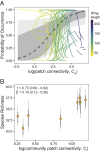The allometry of movement predicts the connectivity of communities
- PMID: 32848069
- PMCID: PMC7486732
- DOI: 10.1073/pnas.2001614117
The allometry of movement predicts the connectivity of communities
Abstract
Connectivity has long played a central role in ecological and evolutionary theory and is increasingly emphasized for conserving biodiversity. Nonetheless, connectivity assessments often focus on individual species even though understanding and preserving connectivity for entire communities is urgently needed. Here we derive and test a framework that harnesses the well-known allometric scaling of animal movement to predict community-level connectivity across protected area networks. We used a field translocation experiment involving 39 species of southern African birds to quantify movement capacity, scaled this relationship to realized dispersal distances determined from ring-and-recovery banding data, and used allometric scaling equations to quantify community-level connectivity based on multilayer network theory. The translocation experiment explained observed dispersal distances from ring-recovery data and emphasized allometric scaling of dispersal based on morphology. Our community-level networks predicted that larger-bodied species had a relatively high potential for connectivity, while small-bodied species had lower connectivity. These community networks explained substantial variation in observed bird diversity across protected areas. Our results highlight that harnessing allometric scaling can be an effective way of determining large-scale community connectivity. We argue that this trait-based framework founded on allometric scaling provides a means to predict connectivity for entire communities, which can foster empirical tests of community theory and contribute to biodiversity conservation strategies aimed at mitigating the effects of environmental change.
Keywords: birds; dispersal; landscape; network; translocation experiment.
Conflict of interest statement
The authors declare no competing interest.
Figures




References
-
- Newbold T. et al. ., Global effects of land use on local terrestrial biodiversity. Nature 520, 45–50 (2015). - PubMed
-
- Tilman D. et al. ., Future threats to biodiversity and pathways to their prevention. Nature 546, 73–81 (2017). - PubMed
-
- Tucker M. A. et al. ., Moving in the Anthropocene: Global reductions in terrestrial mammalian movements. Science 359, 466–469 (2018). - PubMed
-
- Taylor P. D., Fahrig L., Henein K., Merriam G., Connectivity is a vital element of landscape structure. Oikos 68, 571–573 (1993).
Publication types
MeSH terms
LinkOut - more resources
Full Text Sources

